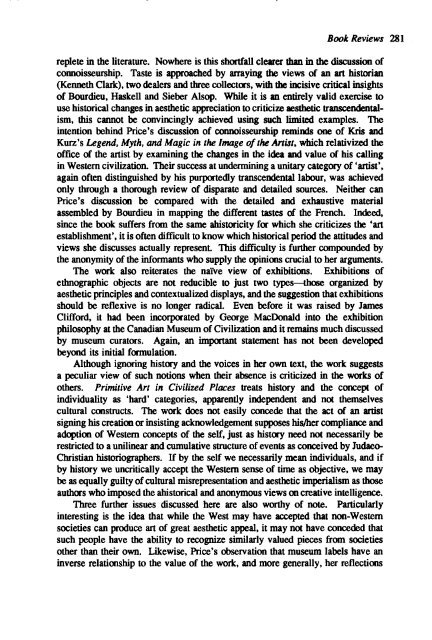1991 No. 1 CONTENTS - Institute of Social and Cultural ...
1991 No. 1 CONTENTS - Institute of Social and Cultural ...
1991 No. 1 CONTENTS - Institute of Social and Cultural ...
You also want an ePaper? Increase the reach of your titles
YUMPU automatically turns print PDFs into web optimized ePapers that Google loves.
Book Reviews 281<br />
replete in the literature. <strong>No</strong>where is this shortfall clearer than in the discussion <strong>of</strong><br />
connoisseurship. Taste is approached by arraying the views <strong>of</strong> an art historian<br />
(Kenneth Clark), two dealers <strong>and</strong> three collectCX's, with the incisive critical insights<br />
<strong>of</strong> Bourdieu, Haskell <strong>and</strong> Sieber Alsop. While it is an entirely valid exercise to<br />
use historical changes in aesthetic appreciation to criticize aesthetic transcendentalism,<br />
this cannot be convincingly achieved using such limited examples. 1be<br />
intention behind Price's discussion <strong>of</strong> connoisseurship reminds one <strong>of</strong> Kris <strong>and</strong><br />
Kurz's Legend, Myth, <strong>and</strong> Magic in the Image 0/ the Artist, which relativized the<br />
<strong>of</strong>fice <strong>of</strong> the artist by examining the changes in the idea <strong>and</strong> value <strong>of</strong> his calling<br />
in Western civilization. Their success at undermining a unitary category <strong>of</strong> 'artist',<br />
again <strong>of</strong>ten distinguished by his purportedly transcendental labour, was achieved<br />
only through a thorough review <strong>of</strong> disparate <strong>and</strong> detailed sources. Neither can<br />
Price's discussioo be compared with the detailed <strong>and</strong> exhaustive material<br />
assembled by Bourdieu in mapping the different tastes <strong>of</strong> the French. Indeed,<br />
since the book suffers from the same ahistoricity for which she criticizes the 'art<br />
establishment', it is <strong>of</strong>ten difficult to know which historical period the attitudes <strong>and</strong><br />
views she discusses actually represent. This difficulty is further compounded by<br />
the anonymity <strong>of</strong> the informants who supply the opinioos crucial to her arguments.<br />
The work also reiterates the naive view <strong>of</strong> exhibitioos. Exhibitions <strong>of</strong><br />
ethnographic objects are not reducible to just two types-those organized by<br />
aesthetic principles <strong>and</strong> contextualized displays, <strong>and</strong> the suggestion that exhibitions<br />
should be reflexive is no longer radical. Even before it was raised by James<br />
Clifford, it had been incorporated by George MacDonald into the exhibition<br />
philosophy at the Canadian Museum <strong>of</strong> Civilization <strong>and</strong> it remains much discussed<br />
by museum curators. Again, an important statement has not been developed<br />
beyond its initial f«mulation.<br />
Although ignoring history <strong>and</strong> the voices in her own text, the work suggests<br />
a peculiar view <strong>of</strong> such notions when their absence is criticized in the works <strong>of</strong><br />
others. Primitive Art in Civilized Places treats history <strong>and</strong> the concept <strong>of</strong><br />
individuality as 'hard' categories, apparently independent <strong>and</strong> not themselves<br />
cultural coostructs. The work does not easily concede that the act <strong>of</strong> an artist<br />
signing his creation or insisting acknowledgement supposes his/her compliance <strong>and</strong><br />
adoption <strong>of</strong> Western concepts <strong>of</strong> the self, just as history need not necessarily be<br />
restricted to a unilinear <strong>and</strong> cumulative structure <strong>of</strong> events as conceived by Judaeo<br />
Christian historiographers. IT by the self we necessarily mean individuals, <strong>and</strong> if<br />
by history we uncritically accept the Western sense <strong>of</strong> time as objective, we may<br />
be as equally guilty <strong>of</strong> cultural misrepresentation <strong>and</strong> aesthetic imperialism as those<br />
authors who imposed the ahistorical <strong>and</strong> anonymous views on creative intelligence.<br />
Three further issues discussed here are also worthy <strong>of</strong> note. Particularly<br />
interesting is the idea that while the West may have accepted that non-Western<br />
societies can produce art <strong>of</strong> great aesthetic appeal, it may not have conceded that<br />
such people have the ability to recognize similarly valued pieces from societies<br />
other than their own. Likewise, Price's observation that museum labels have an<br />
inverse relatiooship to the value <strong>of</strong> the work, <strong>and</strong> more generally, her reflectioos
















